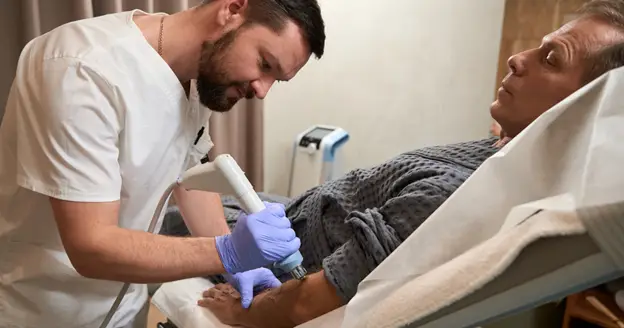Wondering who does shockwave therapy near me? Learn how to find certified practitioners, compare local options, and book the right treatment for your condition.
You’ve tried stretching.
Ice.
Heat.
Rest.
Physical therapy.
Maybe even injections.
But the pain keeps coming back.
Whether it’s your heel, shoulder, elbow, or lower back, chronic pain doesn’t just mess with your body, it messes with your life.
That’s why more people are asking: “Who does shockwave therapy near me?”
It’s a smart question. But also one that leads to a lot of noise.
Sure, Google can give you a list.
But how do you know which clinics are actually qualified?
Who has the right tools?
Who’s using legit protocols and not just cashing in on the buzz around shockwave?
This post breaks it down for you.
You’ll learn:
- What kind of specialist you actually need
- What red flags to watch for
- What to expect from real shockwave treatment
- Why Physis Physical Therapy is the gold standard for pain relief in Midtown
First, What Is Shockwave Therapy (And Why Is Everyone Talking About It)?
Shockwave therapy (also called Extracorporeal Shockwave Therapy or ESWT) is a non-invasive treatment that uses focused pulses of acoustic energy to jumpstart your body’s healing response.
It’s often used for:
- Plantar fasciitis
- Tennis elbow
- Achilles tendinopathy
- Calcific shoulder tendinitis
- Jumper’s knee
- Chronic hip pain
- Trigger points

The idea is simple: break up damaged tissue, stimulate circulation, and encourage repair without surgery or heavy meds.
But Here’s the Catch: The Results Depend on WHO’s Doing It
Shockwave therapy works. But only in the right hands.
Just because a clinic offers it doesn’t mean they’re getting results.
Some places:
- Use low-grade equipment
- Skip patient assessments
- Treat everyone with a cookie-cutter plan
- Rush you in and out like a factory line
You don’t need that.
You need someone who:
- Knows your anatomy
- Understands injury mechanics
- Tailors the settings and protocol for your specific condition
In other words, not just someone, but a qualified musculoskeletal expert.
So, Who Actually Performs Shockwave Therapy Near You?
This depends on the clinic type.
Here’s the breakdown:
✅ Physical Therapy Clinics
These are often the best place to start.Especially ones with sports medicine or orthopedic backgrounds.
Licensed physical therapists understand the musculoskeletal system inside-out.
If they’re trained in shockwave, that’s your sweet spot.
✅ Sports Medicine Clinics
Sports rehab docs and performance specialists often integrate shockwave into recovery plans, especially for athletes with overuse injuries.
✅ Orthopedic Clinics
Some orthopedic surgeons offer shockwave therapy in-house for tendon or joint conditions. They usually do so as a step before recommending surgery.
❌ Chiropractors, Spas, or Wellness Chains
Be careful.
Some of these places offer “shockwave” using weak radial machines or generic protocols. They may not have the clinical knowledge to diagnose or adjust treatment properly.
What Should You Look For in a Shockwave Therapy Specialist?
Forget reviews for a second.
Let’s talk about what actually matters in a treatment setting.
1. Proper Credentials and Experience
Are they a licensed physical therapist, athletic trainer, or rehab specialist?
Have they been trained in administering shockwave for your condition?
How long have they been offering it?
2. Focused vs. Radial Shockwave
Focused shockwave goes deeper and treats more precisely. It’s better for chronic tendinopathy and deep tissue pain.
Radial shockwave is more surface-level. Decent for trigger points or mild inflammation but less effective for serious injuries.
Ask which one they use. Many budget clinics don’t invest in the real deal.
3. Personalized Care
If they don’t assess your injury thoroughly or can’t explain why they’re using shockwave, move on. This isn’t one-size-fits-all.
Look for a clinic that:
- Builds a full treatment plan around your specific case
- Combines shockwave with manual therapy or exercises
- Tracks your progress and adjusts as needed
4. Results, Not Just Hype
It’s easy to throw up a few 5-star reviews on a website.
What you want is:
- Proof of consistent results with similar injuries
- Testimonials from real people with chronic pain stories
- A clear system for measuring improvement

What Does a Session Feel Like?
Let’s be honest, “shockwave” sounds intense. But it is not.
Here’s what to expect:
- You lie down or sit comfortably
- A gel is applied to the target area
- The therapist uses a handheld device that emits quick tapping or pulsing sounds
- You may feel mild discomfort, especially over tender areas
- Most sessions last 10–20 minutes.
- There’s no downtime.
- You might feel sore the next day, like after a workout, but that usually fades fast.
Many patients notice improvement after 2–3 sessions. Full relief usually takes 4–8 depending on the issue.
Why We Recommend Physis Physical Therapy in Midtown
You asked “who does shockwave therapy near me?”
If you’re in or around NYC, the answer is easy: Physis Physical Therapy.
Here’s why they’re miles ahead:
- Top-tier physical therapists with advanced training in orthopedics and sports rehab
- They use cutting-edge focused shockwave machines—not the watered-down versions
- They create a full rehab plan just for you—no cookie-cutter treatment
- They explain everything clearly, track your results, and adjust as needed
- Their clinic is modern, clean, and welcoming without feeling cold or clinical
They’ve helped patients recover from:
- Long-standing plantar fasciitis (even after failed orthotics)
- Post-surgical stiffness and scar tissue buildup
- Repetitive strain injuries in athletes and desk workers alike
One runner with chronic Achilles tendinopathy said they finally ran pain-free after 6 sessions paired with mobility work.
That’s the kind of outcome that keeps people coming back.
If you’re hunting for the best physical therapy Midtown, this is it.
Common Questions Patients Ask
Will insurance cover it?
Most insurance plans don’t cover shockwave therapy (yet), but you can often use FSA/HSA funds. Some clinics offer bundles or packages to make it more affordable.
How many sessions do I need?
It varies. Many people start seeing results in 3–4 sessions. Full recovery might take 6–8. The key is consistency and pairing it with proper rehab.
Does it replace physical therapy?
No. And it shouldn’t.
Shockwave is a tool, not a magic wand. It works best when it’s part of a larger treatment plan involving strength, mobility, and lifestyle changes.
Can I get it on my lunch break?
Yes. There’s no downtime, and sessions are usually under 30 minutes. You can get treated and head straight back to work or your day.
Here’s How to Find the Right Provider Near You
Even if you’re not near Midtown, here’s a quick checklist to help you find someone reputable:
✅ Search “shockwave therapy near me” + your condition (e.g. plantar fasciitis)
✅ Check the clinic’s website: Are they licensed? Do they list focused or radial shockwave?
✅ Read Google and Yelp reviews, but look for depth—not just 5 stars
✅ Call and ask:
- What type of machine do you use?
- Who performs the treatment?
- Is it part of a larger rehab plan?
If they can’t answer those confidently, keep looking.
Final Word: Don’t Just Search—Choose Wisely
Typing “Who does shockwave therapy near me?” is just the first step.
The real results come from choosing the right hands.
You want training, experience, modern tools, and a team that treats you like a person—not a patient on a conveyor belt.
If you’re in NYC, book a consult with Physis Physical Therapy and experience what real, evidence-based recovery feels like.
